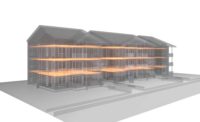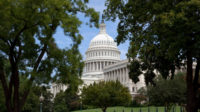Democrats rejoiced at Sen. Barack Obama’s resounding win on Nov. 4 in the presidential race and the party’s strong gains in the House and Senate. But as the cheers from the victory celebration start to fade, Obama’s focus will shift to assembling a Cabinet and setting legislative and regulatory priorities.
As that transition begins, it is clear that the troubled national economy and growing federal deficit will loom over new initiatives that the new administration and new Congress hope to launch.
Voters showed support for infrastructure. The Bond Buyer, a municipal finance publication, reports that 85% of ballot initiatives passed, totaling $44 billion at ENR press time, with another $15 billion too close to call.
Voters approved a $17.9-billion plan to expand mass transit in the Seattle area. And California’s Proposition 1, a nearly $10-billion measure to jumpstart construction of a high-speed rail line that would run the length of the state, had a 52% approval rate. Some industry observers thought that was a stunning outcome. “This just reflects how difficult it is now to get from one end of the state to the other,” says John Baker, senior vice president and Pacific Division manager for Kleinfelder Inc., San Diego. “It was a major surprise.”
But two alternative-energy measures were soundly rejected by California voters. One would have required public and private utilities to obtain at least 20% of their electricity from renewable resources by 2010 and 50% by 2025. The other would have funded rebates to purchasers of alternative-fuel vehicles.
Voters in Colorado also nixed a renewable-energy measure, fearful it would raise home energy bills. But voters in Missouri approved a measure requiring investor-owned utilities to purchase or produce at least 15% of their energy from renewable sources by 2021.
On the federal level, industry officials are heartened by Obama’s support for infrastructure and, despite the deficit, expect him to back a new economic-stimulus bill that they hope will include money for public works. “I think in the short-term they are going to overlook the deficit problems and address some type of investment to get the economy generated again,” says Stephen E. Sandherr, CEO of the Associated General Contractors. “There are projects out there that are ready to go. They will have an immediate impact on the economy”. Some want to see Congress move on a stimulus measure in a lame-duck session, but Sandherr believes it will be held over until next year.
| How Some Infrastructure Initiatives Fared | ||
| APPROVED | ||
| State | Initiative | Amount |
| Calif. | High-speed rail | $9.9 bil. |
| Calif. | Los Angeles schools | $7 bil. |
| Calif. | San Francisco hospital | $887 mil. |
| Wash. | Seattle light rail | $17.9 bil. |
| REJECTED | ||
| Calif. | Alternative fuels | $5 bil. |
| La. | Baton Rouge improvements | $989 mil. |
| Colo. | Jefferson County school repairs | $350 mil. |
| SOURCES: THE BOND BUYER, NATIONAL CONFERENCE OF STATE LEGISLATURES | ||
A major counterweight to longer-range spending plans is a federal budget deficit that the Congressional Budget Office estimates grew to $438 billion in fiscal year 2008 from $162 billion the year before. The recent $700-billion financial rescue legislation and any new stimulus bill would make the 2009 budget gap even larger.
That is not good news for industry officials seeking increases in major spending bills on tap in 2009. Heading the list is a multiyear highway and transit measure. Other items include non-defense appropriations and aviation reauthorization.
“The reality of governing is going to hit...the Obama people like a two-by-four,” says Jay Hansen, National Asphalt Pavement Association vice president for government affairs. “There’s going to be a real reality check.” Steve Hall, American Council of Engineering Companies’ vice president for government affairs adds, “The pot of cash in discretionary money is going to be pretty limited.”
Where will lawmakers find the money to pay for the public-works measures? “That’s the key question,” says Hall. “In some of the cases, Congress is going to have to look at existing revenue streams and find a politically doable way of increasing them—specifically the gas tax.”
Sandherr gives Obama credit for opposing the idea of easing the pain of high gasoline prices by temporarily suspending the motor-fuel levy. But he also expects the president-elect to try to increase other federal revenue by proposing an income-tax hike.
On regulatory matters, including the environment and occupational safety, the new administration is expected to take a more aggressive stance than the Bush team has. “After every election, you find out whether you’re going to be playing offense or defense,” Sandherr says. “We’re going to be playing a lot of defense.”
Obama will benefit from a new Congress that is more solidly Democratic. The party boosted its House ranks by at least 19 members, to a total of 254. In the Senate, Democrats added at least five seats, bringing their total to 54, plus Independent Bernard Sanders (Vt.), who generally votes with Democrats. The other Senate Independent, Joseph Lieberman (Conn.), has caucused with Democrats, but campaigned for GOP presidential candidate Sen. John McCain.
Labor unions spent heavily to elect Democrats. AFL-CIO President John Sweeney says organized labor’s top legislative priority is the Employee Free Choice Act, which would make it easier for unions to organize nonunion workers. Last year, that measure, which opponents term the “card-check bill,” easily cleared the House, but a cloture vote in the Senate failed by nine votes.
AFL-CIO officials say they also plan to talk with Obama’s transition team about nominating pro-union members to the National Labor Relations Board. They also expect the new administration to revisit the issue of union-only project labor agreements on federal construction.
“As an open-shop, free-enterprise contractor, I hope that we are not precluded from the new infrastructure work that will be coming,” says Mark Compton, director of government affairs for American Infrastructure, Worcester, Pa. “PLAs would certainly shut us out and not give us the ability to compete. That is what is keeping me up at night.”
On energy issues, Obama has been a strong supporter of alternative sources, such as wind and solar. “There are a lot of ways we can gain common ground on energy, especially renewable energy, and how our 25,000 [Associated Builder and Contractor] member companies can participate in helping make us more energy independent,” says Bill Fairchild, ABC chairman and president of R.W. Murray Co., a Manassas, Va., contractor.
Jim Owen, spokesman for the Edison Electric Institute, says the candidates generally have expressed “conventional views” on issues such as climate change and requiring electric utilities to derive certain percentages of their power from renewable sources. “We will have to look closely at what concrete proposals come out of this administration after it takes office,” he says. But he expresses concern about the possibility that “overly aggressive timetables” may be set to achieve future goals.




Post a comment to this article
Report Abusive Comment